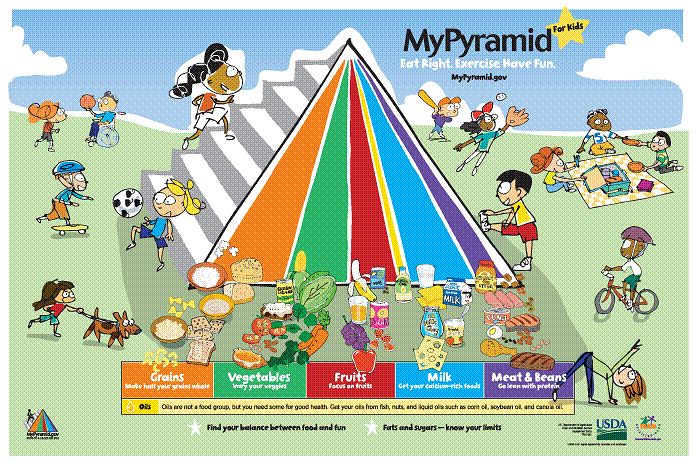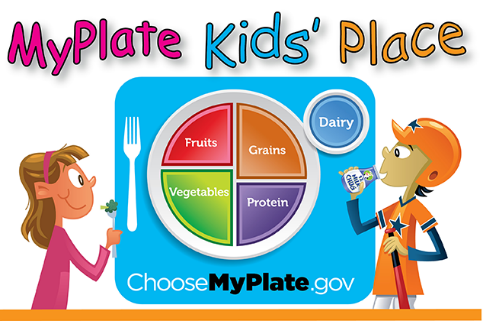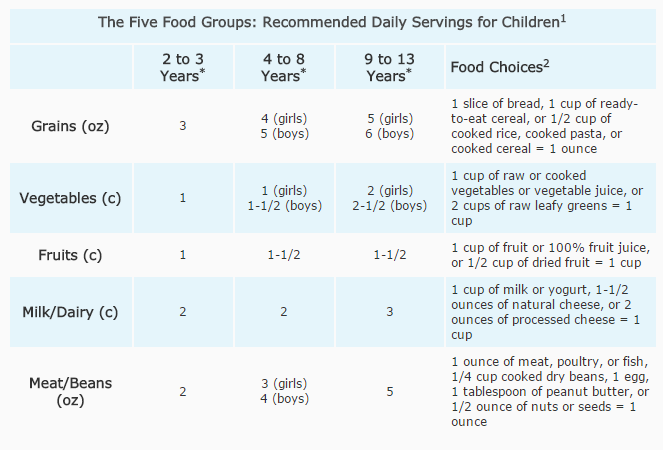The US Centers for Disease Control and Prevention reports that childhood obesity rate has risen more than thrice in the last three decades. Experts agree that the key to preventing this serious health problem is modification of lifestyle habits, which include eating a healthy diet and regular exercise.
Food Pyramid for Kids and My Plate
A food or diet pyramid is a diagram that represents the optimal amount of servings of the basic food groups a child should eat each day to achieve health. The first one was published in 1974 in Sweden, more than 25 other countries and organizations also use food pyramids as guides to a healthy diet. The concept of a Food Guide Pyramid was introduced in 1992 by the United States Department of Agriculture (USDA).

The food pyramid for kids had 6 vertical stripes that represent the five basic food groups plus oils. In the food pyramid, the width of each colored stripe provides children an idea about the amount of servings they need to eat from each food group.
- Orange stripe: Grains
- Green stripe: Vegetables
- Red stripe: Fruits
- Blue stripe: Dairy/Calcium-Rich Foods
- Purple stripe: Proteins
- Yellow stripe: Fats /Oils
The food pyramid for kids was last updated in 2005, and in 2011 it was replaced by a new symbol called MyPlate, a colorful plate features 4 sections that include fruits, vegetables, grains, and protein with dairy as a side order in blue. Just as the food pyramid has stripes with different widths, the plate is divided to show that one must eat more grains, fruits and vegetables than protein.

What Do Kids Need? How Much Do They Need?
To maintain health, your kids must eat a variety of foods that provide many essential nutrients. An easy way to remember this is to make sure that each meal contains food from no less than three of the five groups, and that every snack has food from at least two of the groups. This is why it is important for parents to know more about the five food groups to make sure their kids are getting most of their meals and snacks.

How to Stick the Food Pyramid for Kids at Home
Tips for Families with School-Age Children
- Make half your plate fruits and vegetables on a budget.
• Buy fresh, canned or frozen fruits and vegetables. Look for these in markets and groceries, especially when there’s a sale. Buy food to last until the next shopping trip.
• Choose frozen foods that have no added fat, sugar or salt.
• Choose canned fruits that are packed in water or 100% juice.
• Choose canned vegetables that have no salt added.
- Start every day with whole-grains.
• For breakfast, choose cereals, breads, or pancakes made with whole-grains.
• Whole grains products have more fiber and will help kids feel full longer and allow them to maintain alertness in school.
• Choose 100% whole wheat food products or 100% whole grain products. Check the ingredients list and look for the word “whole” on the first listed ingredient. If you see whole-wheat flour, for example, then that’s whole grain.
- Milk matters.
Like adults, children need protein, calcium, and vitamin Dfor strong muscles, bones, and teeth. These nutrients are found in milk.
• Choose fat-free/low-fat (1%) milk to take with meals.
• If your child is lactose intolerant, choose lactose-free/lactose-reduced products or soy beverages that are calcium-fortified.
A Daily Food Plan for Kids of 6-8 Years Old
Grains: Make sure that at least one half their grains are whole grain.
For a 1200-Calorie diet, your goals are to eat 4-ounce (oz) equivalents, where 1-oz equivalent is roughly 1-oz ready-to-eat cereals, 1 slice bread, or 1/2 c of cereal, pasta,or cooked rice.
Vegetables: Try to eat a variety of vegetables every day, picking from different subgroups such as dark green, red and orange vegetables, beans and peas, starchy vegetables and others.
For a 1200-Calorie diet, your goals are to eat: 1½ c of vegetables, where 1 cup = 1 c of raw/cooked vegetables, 2 c leafy greens or 1 c 100% vegetable juice.
Fruits: Choose fresh, canned, frozen, and dried fruits more often than fruit juice.
For a 1200-Calorie diet, your goals are to eat: 1 cup of fruits, where 1 cup = 1 c raw /cooked fruits, 1/2 c dried fruit, or 1 c 100% fruit juice.
Dairy: Include in your diet fat-free/low-fat dairy foods every day.
For a 1200-Calorie diet, your goals are to eat: 2 ½ cups dairy, where 1 cup = 1 c milk or yogurt or fortified soy beverages, 2 oz processed cheese or 1 ½ oz natural cheese
Protein Foods: Aim to eat a variety of protein-rich foods like seafood, lean meat, poultry, peas, beans, nuts, and seeds every week.
For a 1200-Calorie diet, your goals are to eat: 3 ounce equivalents, wherein 1 oz = 1 egg, 1 oz lean meat poultry/seafood, 1/4 c cooked beans/peas, 1/2 oz nuts/ seeds, or 1 tablespoon peanut butter
For more detailed plans for ages varying from 2 to 18+ years old, please click HERE.
